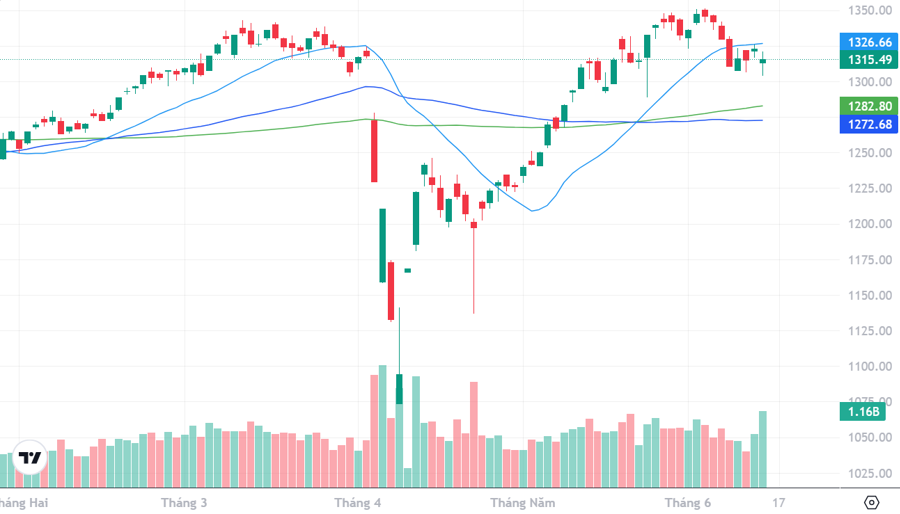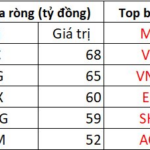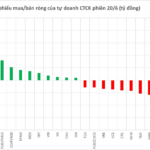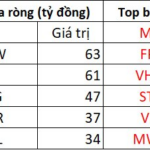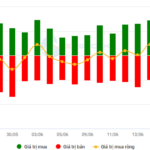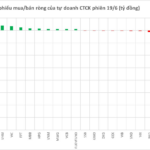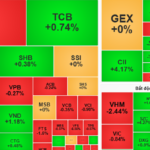The market unexpectedly performed quite positively last week as the VN-Index quickly ended its correction phase and rebounded by 2.6%, once again testing the mid-term peak. Despite the portfolio restructuring activities of foreign ETFs, overall liquidity did not show the necessary surge.
Experts are cautious about this repeated pattern as this is also the third time that the VN-Index has hovered near the peak, but the large-cap stocks have played a significant role, and liquidity has not increased significantly, with poor money flow.
The most optimistic scenario expected is that the market will continue to hover around the high zone, awaiting a breakthrough information stimulus or a surge in money flow. However, the scenario of creating a “bull-trap” is also considered when the Middle East conflict hotspot still exists and is heating up.
Experts also noted that the market is entering a critical time frame with only one week left until the end of June, and the time frame for the countervailing duty rate will only last until the first week of July. There have been some unofficial revelations about this tax rate, for example, Nomura Investment Bank forecasts that Vietnam will have an average tax rate of 24.3%. Experts evaluate this as the tax rate in the baseline scenario of many securities companies. The common view is that even if it is only half of the initial rate (46%), it will still have an impact because this is only an additional tax. However, experts also expect there will be different tax rates for different industries, and this will cause the market to reprice industry prospects as well as stocks within the industry.
Although the VN-Index has returned to the old peak and closed at a higher index point than in March 2025, experts do not consider it a buy signal. Some even worry about the activity of pulling the pillar and “bull-trap”. Therefore, most experts still maintain a medium to high portfolio ratio without making new purchases.
Nguyen Hoang – VnEconomy
The market performed quite unexpectedly last week. Instead of a consecutive correction phase, the market rose positively, and the VN-Index once again returned to the old peak. In the previous discussion, you did not rate this recovery scenario highly. So, what is the driving force that helps the market recover and challenge the peak again? Will the market be able to break through this time or will it still repeat the pattern of pushing the pillar as before?

The lack of a surge in liquidity, combined with the fact that the VN30 futures contract maintains a very wide discount (negative basis), reinforces caution. This signal indicates that a group of institutional investors are defending their positions or even betting on a possible market correction.
Mr. Nghiem Sy Tien
Mr. Nghiem Sy Tien – Investment Strategy Analyst, KBSV Securities
The main driving force for this recovery comes from the leading role of the banking stock group, especially the large-cap codes. Money flow has been concentrated in this group, creating a spillover effect and pulling the index back to test the peak.
However, the “pushing the pillar” scenario is still quite clear when the general liquidity has not really exploded, and the market breadth is not convincing. This test will require a decisive breakout session with a sharp increase in trading volume and the participation of many other sectors to confirm a sustainable upward trend. If not, the risk of repeating the old correction pattern still exists.
Ms. Nguyen Thi My Lien – Head of Analysis Department, Phu Hung Securities Company
The market approached the old peak last week, but liquidity declined, and money flow remained polarized. Vietnam’s stock market recorded good performance compared to global markets when the conflict between Israel and Iran is dominating. The driving force is probably due to expectations of a stable political environment, along with flexible and adaptive management policies, which have helped boost investor confidence. In addition, the market sentiment may be hopeful about the positive results from the countervailing duty negotiations between Vietnam and the US as the 90-day period is approaching.
Mr. Le Duc Khanh – Director of Analysis, VPS Securities
After the strong increase in April, the upward movement in May also changed investors’ views on forecasting the stock market volatility in the short term. The scenario of breaking the peak of the 1340-1350 zone has become clearer with a higher probability when the VN-Index has twice returned to touch the 1350 +/- point mark. The fluctuation phase in the 1300-1330-1350 zone is also understandable.
I assess that the domestic growth momentum is still quite good, and money flow into the market remains high. Breaking the peak towards the 1400-1450 point mark from the end of June to Q3 is very high. Sooner or later, there will be breakthrough increases – the time has come and is approaching.
Mr. Le Minh Nguyen – Senior Director of Individual Customers, Rong Viet Securities
Although the market liquidity was not as high as the previous week, the VN-Index still had a surprising week of gains, returning to the old peak. Trading movements show that money flow is accumulating around the old peak and tends to wait for supporting information to break out. I think the forecast of the business results of the listed companies in the first 6 months with expected good growth pushed the index up to the old peak. However, the market is expected to polarize strongly between stocks in the coming period.
Nguyen Hoang – VnEconomy
The notable drop in liquidity during the week of returning to the old peak is a noteworthy point, while a breakthrough peak is usually accompanied by enthusiastic spillover and explosive liquidity. Is this an unfavorable signal, or is the market “breaking the peak in doubt”, especially when the VN30 index futures contract is at a very wide discount?
Ms. Nguyen Thi My Lien – Head of Analysis Department, Phu Hung Securities Company
I agree that the drop in liquidity when the index breaks the peak is a point to note. This could be a cautious reaction from large money flow. Derivatives are also significantly lower than VN30, indicating that future price expectations may stall. Money flow is currently rotating quite quickly without staying long in one industry group, typically the reaction in the Oil and Gas group: Prices were active at the beginning of the week but were almost wiped out by the end of the week when world oil prices changed. If liquidity or spillover does not improve in the coming sessions, there is still a risk of correction.
Mr. Le Minh Nguyen – Senior Director of Individual Customers, Rong Viet Securities
Although the positive sentiment pushed the VN-Index back to the old peak, the general market sentiment remains cautious amid global political and macroeconomic uncertainties. I expect the upcoming business results will be the “stimulus” for the market to break out strongly.
Mr. Nghiem Sy Tien – Investment Strategy Analyst, KBSV Securities
Usually, a healthy “break-through-the-peak-in-doubt” scenario occurs when small individual investors are hesitant, but large money flow quietly participates. However, in this case, the drop in liquidity shows that even large money flow is not really determined.
Especially, when combined with the fact that the VN30 futures contract maintains a very wide discount (negative basis), it reinforces caution. This signal indicates that a group of institutional investors are defending their positions or even betting on a possible market correction.
Therefore, instead of a positive scenario, this signal is more unfavorable, warning of an unsustainable uptrend and the potential for a “bull trap” (price increase trap). The market needs a breakout session with a sharp increase in trading volume to break this stalemate.

In my opinion, we should maintain a balanced ratio between cash and stocks to wait for accurate signals about the market trend and make disbursements at the best time.
Mr. Le Minh Nguyen
Mr. Le Duc Khanh – Director of Analysis, VPS Securities
In my opinion, the stage of forming a cumulative base in the 1300-1340-1350 zone may take longer – liquidity does not necessarily have to increase strongly in the past two weeks. Next week and the beginning of July are more important when the total market liquidity will have to show larger and more explosive trading values. The market is breaking the peak in the doubt of a group of investors and still has to continue on its path – going up in the medium term…
Nguyen Hoang – VnEconomy
Information about potential countervailing duty rates has begun to be revealed, for example, Nomura Investment Bank forecasts that Vietnam will have an average tax rate of 24.3%, higher than some other countries in the region. Some other forecasts are in the range of 20%-25%. What do you think will be the market’s reaction to this tax rate if it is the final number?
Mr. Le Minh Nguyen – Senior Director of Individual Customers, Rong Viet Securities
The market recovery after the countervailing duty shock shows that it has partly reflected the market value. I think that with the figure of 24.3% higher than some other countries in the region will affect the market to some extent. But overall, the market sentiment has accepted the fact that countervailing duties will be imposed, so this reaction may not last long.
Ms. Nguyen Thi My Lien – Head of Analysis Department, Phu Hung Securities Company
Recent information about the negotiations has also been gradually welcomed by the market. Some countries have reached preliminary negotiations with the US, such as the UK and China, showing the difficulty of getting the countervailing duty rate down. I think the market has discounted the information and changed its expectations, no longer optimistic at the low level of 10-15% but now the general consensus is also in the range of 20-25%. If the final result is lower, it will be a positive catalyst for the market. In case the result falls into this frame, there will probably be a phase of reshaping the trend, with a scenario leaning towards sideways fluctuations. Meanwhile, I think a tax rate above 30% will be a signal to be cautious.
However, I see a positive point that the tax rate can be applied to each industry, and this was also mentioned by the Trump administration, not necessarily a common tax rate for the whole economy. In other words, there will still be some less affected or benefited industries, and I expect the market to objectively evaluate even if the final number is.
Mr. Le Duc Khanh – Director of Analysis, VPS Securities
In my opinion, the information has also been reflected in the recent market movements. The positive performance of seafood, textiles, and port stocks in the last session of the week is also a testament to this. The stock market will hardly have negative fluctuations like the April period but, instead, stability and positive accumulation movements in an upward trend will reflect the true state of the economy, Vietnam’s development potential this year. Even with difficulties and challenges, growth, development space, and market upgrade potential – many positive signals from US-China trade negotiations – the countervailing duty rate has been reduced by half, which is also a positive signal.

I think the market has discounted the information and changed its expectations, no longer optimistic at the low level of 10-15% but now the general consensus is also in the range of 20-25%. In case the result falls into this frame, there will probably be a phase of reshaping the trend.
Ms. Nguyen Thi My Lien
Mr. Nghiem Sy Tien – Investment Strategy Analyst, KBSV Securities
Although the tax rate of 20-25% is the baseline scenario of many securities companies, the market is likely to still have an immediate corrective reaction to this tax rate. In my opinion, even if it is lower than the initial rate of 46%, the threshold of 20-25% will still have a significant impact on trade activities and FDI capital inflows into Vietnam, while relatively reducing the competitiveness compared to other competitors in the region.
Nguyen Hoang – VnEconomy
Investors seem indifferent to the event of VN-Index breaking the peak. Do you consider the index movement a buy signal? What is the current stock ratio?
Ms. Nguyen Thi My Lien – Head of Analysis Department, Phu Hung Securities Company
I often consider the general index as an “environment” for reference in making decisions, not entirely based on it. This can be considered as a variable among many variables, and used in combination to give a signal. The market scale is now larger, and the movement of money flow is also more flexible. There have been many industry groups and stocks that have diverged from the main index in the past time. On the other hand, the main index is also affected by large-cap stocks, which can cause noise.
Currently, the stock ratio in my portfolio is at 80%. If the market liquidity and consensus improve, I will increase the ratio further. However, on the cautious side, we still need to pay attention to the potential external instability, and investors should not be too excited if the context is not clear.
Mr. Nghiem Sy Tien – Investment Strategy Analyst, KBSV Securities
In my opinion, the positive movement last week was not enough of a certain technical signal to serve as a basis for increasing the ratio or opening new positions. Depending on the movement of money flow, I will partially take profits if the index expands the increase but lacks accompanying liquidity because, in that case, the risk of a “price increase trap” will be higher.

The next week and the beginning of July are more important when the total market liquidity will have to show larger and more explosive trading values. The market is breaking the peak in the doubt of a group of investors.
Mr. Le Duc Khanh
Mr. Le Minh Nguyen – Senior Director of Individual Customers, Rong Viet Securities
The general market sentiment remains optimistic amid global political and macroeconomic uncertainties. I expect the upcoming business results will be the “stimulus” for the market to break out strongly. Investors can invest or restructure their portfolios during market correction sessions, avoiding chasing stocks during market up sessions. In my opinion, we should maintain a balanced ratio between cash and stocks to wait for accurate signals about the market trend and make disbursements at the best time.
Mr. Le Duc Khanh – Director of Analysis, VPS Securities
The market rose to the old peak – the index did not increase much, not to mention
Foreign Sell-Off Surges Over $37 Million on Futures Expiry, Dumping Blue-Chip Stocks
The sell-off continued into the afternoon, with FPT stocks witnessing a massive foreign sell-off, amounting to a staggering 389 billion VND.
Stock Market Update for Week of June 16-20, 2025: Navigating Volatility Around the 1,350-point Threshold
The VN-Index witnessed a slight decline, failing to sustain the 1,350-point mark in the week’s final session. The index’s candlestick chart displayed a series of long shadows, indicating investor hesitation around previous peak levels. With foreign investors’ net selling trend likely to persist, the short-term upward trajectory may encounter challenges, as evident from the below-average trading volume maintained over the past 20 days.


























